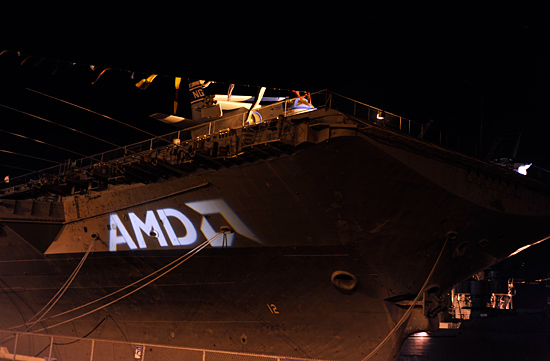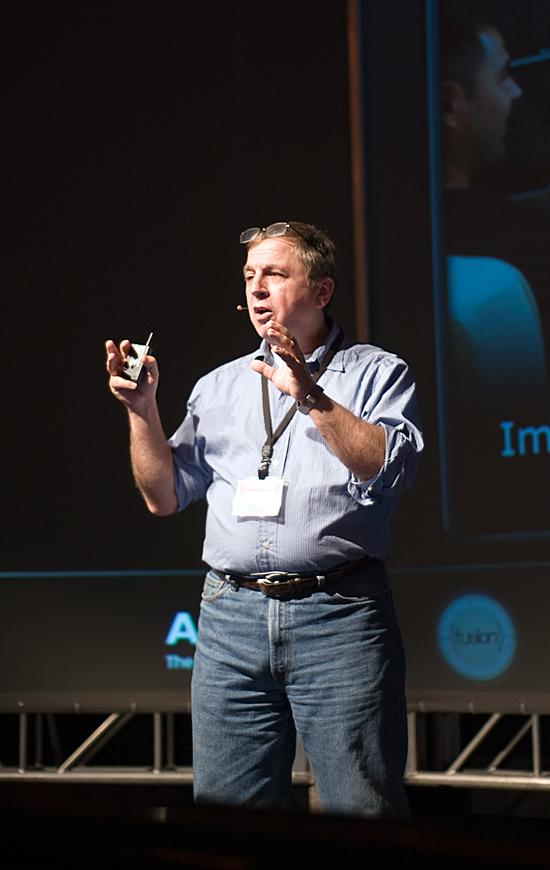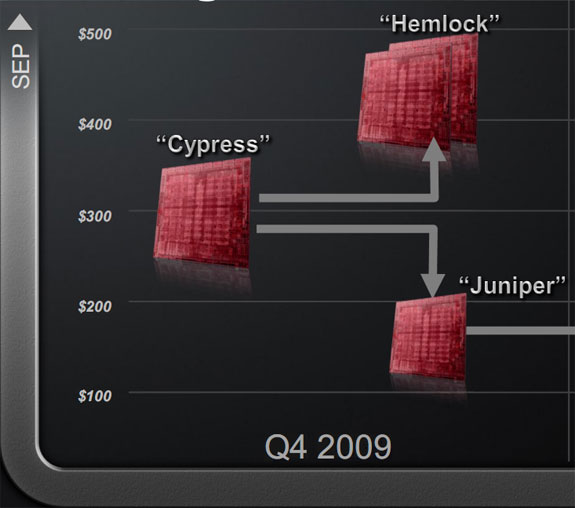The RV870 Story: AMD Showing up to the Fight
by Anand Lal Shimpi on February 14, 2010 12:00 AM EST- Posted in
- GPUs
The Call
My love/hate relationship with AMD PR continued last year. But lately, it’s been far less hate. Let’s rewind back to the Summer of 2009. I’d been waiting for AMD to call for weeks.
We all knew that the RV870 was going to launch sometime before the end of the year, and we’re normally briefed on new GPUs around a month or so before we get hardware. The rumors said that the launch had been pushed back, but just like clockwork I got a call in June or July of last year. It was my old friend, Chris Hook of AMD PR.

This time he wanted me to come to a press event on a carrier off the coast of California. Sigh.
It’s not that I have anything against carriers. It’s just that all I cared about at that time was the long awaited successor to the RV770. The RV770 was the GPU that unequivocally restored my faith in ATI graphics, an impact shared by others last June. But that’s not how the game is played I’m afraid. AMD promises its management and its partners that they can fill a room (or carrier) up with important press. We get promised access to engineers, useful information and free drinks.

The USS Hornet. GPUs are in there.
I’m not easily swayed by free drinks, but Chris Hook knows me well enough by now to know what I’d appreciate even more.
The Dinner - September 2009
I had to leave dinner earlier than I wanted to. ASUS’ Chairman Jonney Shih was in town and only had one opportunity to meet me before I left Oakland. Whenever either of us happens to be in the same town, we always make our best effort to meet - and I wasn’t going to let him down. In the same vein that Steve Jobs is successful because he is a product guy at heart, running a company best known for its products. Jonney Shih is an engineer at heart, and he runs a company who has always been known for their excellence in engineering. This wasn’t just another meeting with an executive, this was a meeting with someone who has a passion for the same things I do. His focus isn’t on making money, it’s on engineering. It’s a rare treat.
My ride was waiting outside. I closed the lid on my laptop, making sure to save the 13 pages of notes I just took while at dinner. And I shook this man’s hand:

Before I left he asked me to do one thing. He said “Try not to make the story about me. There are tons of hardworking engineers that really made this chip happen”. Like Jonney, Carrell Killebrew has his own combination of traits that make him completely unique in this industry. All of the greats are like that. They’ve all got their own history that brought them to the companies that they work for today, and they have their own sets of personality traits that when combined make them so unique. For Carrell Killebrew it's a mixture of intelligence, pragmatism, passion and humility that's very rare to see. He's also a genuinely good guy. One of his tenets is that you should always expect the best from others. If you expect any less than the best, that’s all you’ll ever get from them. It’s a positive take on people, one that surprisingly enough only burned Carrell once. Perhaps he’s more fortunate than most.
Mr. Killebrew didn’t make the RV870, but he was beyond instrumental in making sure it was a success. What follows is a small portion of the story of the RV870, the GPU behind the Radeon HD 5800 series. I call it a small portion of the story because despite this article using more than eight thousand words to tell it, the actual story took place over years and in the minds and work of hundreds of engineers. This GPU, like all others (even Fermi) is the lifework of some of the best engineers in the industry. They are the heroes of our industry, and I hope I can do their story justice.
As is usually the case with these GPU backstories, to understand why things unfolded the way they did we have to look back a few years. Introducing a brand new GPU can take 2 - 4 years from start to finish. Thus to understand the origins of the Radeon HD 5800 series (RV870) we have to look back to 2005.
Sidebar on Naming
AMD PR really doesn’t like it when I use the name RV870. With this last generation of GPUs, AMD wanted to move away from its traditional naming. According to AMD, there is no GPU called the RV870, despite the fact that Carrell Killebrew, Eric Demers and numerous others referred to it as such over the past couple of years. As with most drastic changes, it usually takes a while for these things to sink in. I’ve also heard reference to an RV870 jar - think of it as a swear jar but for each time someone calls Cypress an RV870.

Why the change? Well, giving each member of a GPU family a name helps confuse the competition. It’s easy to know that RV870 is the successor to the RV770. It’s harder to tell exactly what a Cypress is.
AMD PR would rather me refer to RV870 and the subject of today’s story as Cypress. The chart below shows AMD’s full listing of codenames for the 40nm DX11 GPU lineup:
| GPU | Codename |
| ATI Radeon HD 5900 Series | Hemlock |
| ATI Radeon HD 5800 Series | Cypress |
| ATI Radeon HD 5700 Series | Juniper |
| ATI Radeon HD 5600/5500 Series | Redwood |
| ATI Radeon HD 5400 Series | Cedar |
Given that we still haven’t purged the RVxxx naming from our vocabulary, I’m going to stick with RV870 for this story. But for those of you who have embraced the new nomenclature - RV870 = Cypress and at points I will use the two names interchangeably. The entire chip stack is called Evergreen. The replacement stack is called the Northern Islands.










132 Comments
View All Comments
tomoyo - Monday, February 15, 2010 - link
Another awesome article about the real situation behind the hardware from you Anand! I was on the USS Hornet and wish I had talked to you, but it was a great time nonetheless. It's interesting the change in their thought process between the RV770 and RV870, I hope they keep the winning streak up for the next refresh cycle (which hopefully will stay on the market bulges).WT - Monday, February 15, 2010 - link
*sigh* ^^^There's always one in the crowd.
Take care in the fact that you are the only person who hasn't enjoyed this read.
MegaManX4 - Monday, February 15, 2010 - link
Reminds me much of the Anglo-Saxon "documantaries", where it is always of tertiary relevance WHAT is actually discussed, but it is always of utmost interest how the responsible person "feels" about what he is just seeing, other than just stating the facts.There seems to be a huge crowd vowing for that kind of journalism, Whatever pleases the canaille.
"Jedem das Seine" or "to each his own" then
MegaManX4 - Monday, February 15, 2010 - link
This was actually the worst article i have ever read at anandtech. I know that you Americans always strive for emotionally .Driven stories, but this outright borders on silly exaggeration."Heroes of our Industry", what a Schmalz.
Also, if one would take the real informations presented in that article, it wouldn't justify even a 2 Page Article, let alone that 11 Page behemoth.
They are engineers, they do their jobs. Nothing more, nothing less.
Greetings from Germany
blowfish - Monday, February 15, 2010 - link
hmm, with an attitude like that you'll never get past middle management!Like most here, I loved this article. Anand obviously has the friendship and respect of some very senior players, and we were treated to some great insights into how things work at AMD ATI.
As the reader, you can choose to read or not read the article, simple as that. Maybe you should up your medication.
MegaManX4 - Monday, February 15, 2010 - link
unreasonable polemicpmonti80 - Monday, February 15, 2010 - link
You are the one being unreasonable. This may not be a "scientifically written" article, but no one is claiming it to be. And that's the reason this article is so interesting.saiga6360 - Thursday, February 18, 2010 - link
Apparently German engineers are just soulless robots. His confusion is understandable.BelardA - Monday, February 15, 2010 - link
I enjoyed this article even more than the RV770. I do recommend that everyone read that one too.Kind of shocking that Nvidia didn't use that info from the RV770 article to learn to NOT make big GPUs like the GTX 2xx. yeah yeah, it takes 2-4 years to design a chip.
I thank ATI (and AMD) for not playing marketing games like Nvidia does... I think they have a bigger marketing department than engineers nowadays. They started with the GF2-MX 400 & GF4-MX cards (which were re-labeled updated GF2 cards that were not up to GF3 standards)... but the latest cluster-muck of Nvidia products is nothing but a mess. 8800 re-badged as a 9800 re-badged into the gts 250. Code-name of NVxx go to G80 to G92 to G100. The GT-1xx products that are actually low-end 9xxx products, same with most G200 & G300. I'm not going to be surprised when the GTX 285 gets renamed into the GTS450 at $200! I've seen people who bought the GTS250 and post on the internet "why isn't my new gts250 much faster than my old 8800GT"... because you bought a faster version of your card and thought it was something new. Wow, 3 years with 3 names for the same product, that is marketing.
ATI does good with the entire 4000 series being DX 10.1 products and 5000s are DX11. (Does anyone really use HD-5xxx?) It doesn't feel like ATI is pulling our chain with their products.
AMD should be learning from ATI, they are getting better with CPUs - 2 years late, but AMD CPUs are now faster than Core2 and compete well against the lower end intel i-confused model CPUs. There is still room for improvement which was recommend to them some time ago, but AMD is just going to come out with a new design for next year. But had AMD tweaked their CPUs a bit for another 10~20% performance, they'd be up there with i7s.
I hope in the next ATI GPU, some form of Physics engine is added to go up against nvidia's PhsyX. But perhaps that'll be part of DX12... but Microsoft no longer supports Games for Windows.
Actually, with more and more games going ONLY to consoles, I don't think the need for high-end gaming cards will be needed anymore in the next few years. If there are no games, who needs a $300 3D Gaming card?
Zink - Monday, February 15, 2010 - link
Would also like to say great article. I can't wait for new distributed computing cores come out optimized for ATI's architectures.